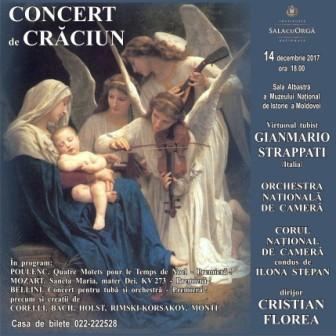  Events Archive Events Archive
Christmas concert
December 14, 2017
The National Museum of History of Moldova hosted on 14th December 2017 a Christmas Concert offered by the Organ Hall from Chișinău. Under the musical direction of conductor Cristian Florea performed the National Chamber Orchestra and the National Chamber Choir, together with soloist, a virtuoso trumpeter, Gianmario Strappati (Italy).
From the concert program:
Arcangelo Corelli (1653-1713)
Concerto grosso in sol minor
„Fatto per Notte di Natale", op. 6 no. 8 (1690?)
I. Vivace - Grave. Arcate, sostenuto e come stà
II. Allegro
III. Adagio - Allegro - Adagio
IV. Vivace
V. Allegro - largo. Pastorale ad libitum Wolfang Amadeus Mozart (1756-1793)
Sancta Maria, mater dei for choir and orchestra, KV 273 (1777) Francis Poulenc (1899-1963)
Quatre motets pour le temps de Noël for mixed choir, FP 152 (1951-1952)
I. O magnum mysterium (Oh big mystery)
II. Quem vidistis pastores dicite (Shepherds, tell us what you have seen)
III. Videntes stellam (We saw the star)
IV. Hodie Christus natus est (Today Christ is born) Gustav Holst (1874-1934)
St. Paul's suite for string orchestra, op. 29 no. 2 (1912-1913)
I. Jig
II. Ostinato
III. Intermezzo
IV. Finale (the Dargason) Vincenzo Bellini (1801-1835)
Concert in Mi-bemol major for oboe and orchestra (1823) /It is played on the tuba /
Risoluto allegro - Larghetto cantabile - Allegro polonese Johann Sebastian Bach (1685-1750)
Aria from Suite for orchestra no. 3 in Re major, BWV 1068 Nikolai Rimski-Korsakov (1844-1908)
Flight of the cockchafer
Variation for tuba and orchestra Vittorio Monti (1862-1922)
Ceardaș
Variation for tuba and orchestra
|











 31 August 1989 St., 121 A, MD 2012, Chisinau, Republic of Moldova
31 August 1989 St., 121 A, MD 2012, Chisinau, Republic of Moldova



















































